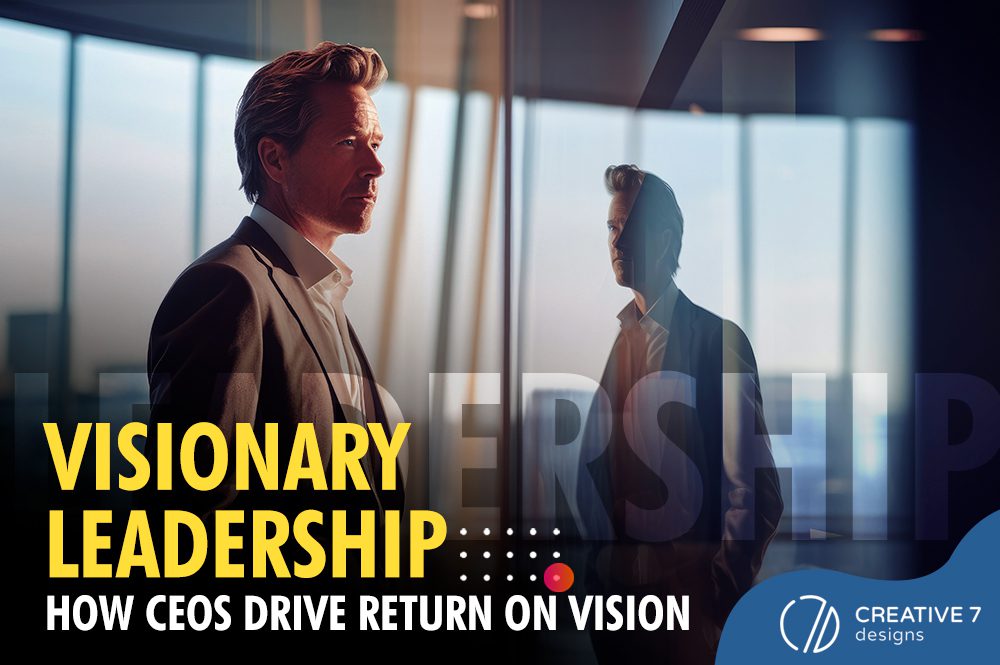Overview: How do top CEOs turn visionary thinking into tangible success? Uncover the secrets in our latest blog! Explore how clear direction, strategic alignment, and other factors work in unison to drive substantial “Return on Vision,” setting the stage for unparalleled business triumph.
In today’s rapidly changing business landscape, CEOs are facing unprecedented challenges. They are not only responsible for the day-to-day operations of their companies but also for charting a course toward a brighter future. We like to refer to the results of a business vision as the “Return on Vision,” and paying attention to it is a critical factor in a company’s long-term success.
In this blog post, we’ll explore what Return on Vision means and how CEOs can effectively drive it to ensure their organizations thrive in the years to come.
Defining Return on Vision
Return on Vision (ROV) is a concept that goes beyond traditional financial metrics like Return on Investment (ROI). While ROI measures the monetary returns generated by an investment, ROV focuses on the broader impact of a CEO’s vision on the company’s overall success. It encompasses the ability to transform ideas, strategies, and values into tangible results and positive outcomes.
Here are some key elements that set the stage for a rewarding ROV:
Clarity of Purpose: A CEO’s vision should be clear and easily understood by employees, stakeholders, and customers. It should provide a sense of direction and purpose for everyone involved.
Alignment: A positive ROV is achieved when all aspects of the organization align with the CEO’s vision. This includes the company’s culture, strategy, operations, and customer relationships.
Innovation: A visionary CEO encourages innovation and adapts to changing market dynamics, ensuring the organization stays ahead of the curve.
Long-Term Perspective: ROV isn’t about short-term gains but rather about making sure that the groundwork is laid for a sustainable and prosperous future for the company.
Now that we understand the concept of ROV, let’s explore how CEOs can drive it effectively.
Effective Communication: CEOs need to communicate their vision clearly and regularly. They should ensure that everyone in the organization understands how their role contributes to the bigger picture.
Lead by Example: CEOs must embody the values and principles of their vision. By demonstrating their commitment, they inspire employees to follow suit. By championing successes that align with the vision, learning openly from failures, and maintaining a transparent dialogue about the journey, CEOs can personify their company’s vision.
Foster Innovation: Encouraging a culture of innovation is key to achieving a great ROV. CEOs should create an environment where employees feel empowered to suggest and implement new ideas.
Invest in Talent: Hiring, developing, and retaining the right talent is essential for bringing a vision to life. CEOs should invest in their employees’ growth to ensure they can execute the vision effectively.
Measure Progress: For a solidly quantifiable way to keep track of of ROV, CEOs should establish key performance indicators (KPIs) and regularly track progress towards their vision. This allows for adjustments when necessary and keeps everyone focused on the end goal.
Customer-Centric Approach: A CEO’s vision should ultimately benefit customers. By focusing on customer needs and experiences, CEOs can ensure their vision translates into customer satisfaction and loyalty.
Measuring ROV: Metrics That Matter
To quantify the impact of visionary leadership and ROV, CEOs rely on specific metrics:
Market Expansion : CEOs track the company’s market expansion efforts, ensuring that their vision translates into a broader reach and increased market share.
Employee Retention and Engagement : A motivated and engaged workforce is a hallmark of visionary leadership. CEOs monitor employee retention rates and engagement levels to gauge alignment with the vision.
Customer Loyalty and Advocacy : Loyal customers who advocate for your brand are a testament to the success of your vision. CEOs assess customer satisfaction, retention, and the growth of brand advocates.
Financial Performance : While not the sole focus, financial indicators still matter. CEOs track metrics like revenue growth, profitability, and return on investment (ROI) to ensure that their vision aligns with the organization’s financial health.
>> Related Reading: Measuring Marketing ROI: Metrics and Tools for Success
One of the leading examples is Apple’s Vision and Mission Statement — Apple Inc. serves as a prime example of a company with a strong ROV. Steve Jobs, the co-founder, and former CEO, had a clear vision of making technology accessible and user-friendly. His unwavering commitment to innovation and design excellence transformed Apple into a global tech giant.
Jobs communicated his vision effectively, leading to a dedicated fan base and record-breaking product launches. Apple’s success was not just about financial gains but also about changing the way people interact with technology.
In Summary
Visionary CEOs are the architects of success who drive Return on Vision through their commitment to a grand vision, their ability to build high-performance teams, their embrace of innovation, and their resilience in the face of challenges.
By measuring the impact of their visionary leadership through meaningful metrics, they ensure that their organizations not only thrive financially but also leave a lasting legacy that shapes the future of their industries and communities.
Reach out to Creative 7 Designs for more!


